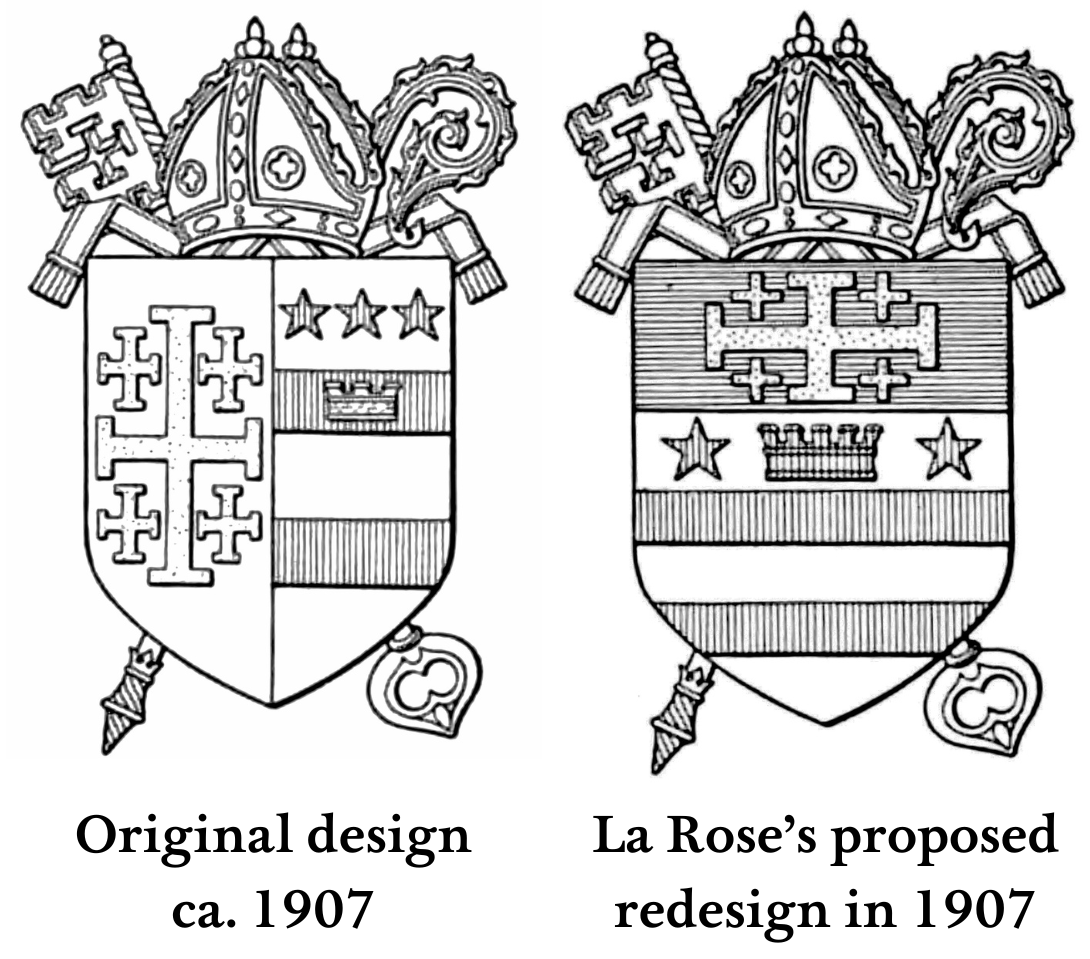 |
Seal and arms of the Diocese of Washington
Rendered by Chad Krouse, 2025 |
There stands out one coat of arms which drew wrath from the pen of Pierre de Chaignon la Rose (1872-1941) regarding the state of heraldry in the Episcopal Church. The heraldic designer from Harvard made his life's mission to correct the wrongs inflicted by arm chair heralds in the US during the early-to-mid 20th Century and set a new standard for corporate heraldry. The coat of arms of the Episcopal Diocese of Washington, DC quickly became la Rose's favorite target highlighting the gross misunderstanding shared by many Americans when designing arms.
Excerpt from la Rose (1907):
Perhaps the worst of all, as even though unconsciously, the most impudent and misleading of American coats [Diocese of Washington, DC]...From the foregoing it will be seen: first, that the dexter impalement of the diocesan arms is an incorrect version of the arms of the kingdom of Jerusalem; and secondly, that in using these arms the diocese and bishop are guilty of a bit of heraldic assumption which even the Patriarch of Jerusalem or the Anglican bishop in Jerusalem would never dream of" (64).
In the same article, the heraldic designer proposed the following revision:
.png) |
| La Rose's (1907) illustrations published in his article. |
La Rose's revision appears deceptively simply, yet this coat reveals a level of mastery already at work in his early heraldic career--combining all the desired elements and yet clearly providing geographical identification at the same time.
 |
Arms of George Washington.
Rendered by Chad Krouse, 2024. |
The blazon la Rose created for his proposal: Argent, two bars and in chief, between as many stars, a mural crown of five towers all Gules; on a chief Azure a Jerusalem cross Or (La Rose, 1907).
 |
Arms of the Episcopal Diocese of Washington
Rendered by Chad Krouse, 2024 |
Sometimes, however, those great designs cannot break through rife heralditis. As such, the Diocese of Washington, DC would not take action on la Rose's proposal for 39 years.
Retired US-Army Major George Moseley Chandler (1876-1961), a former member of the Joint Commission on Flag and Seal, was the layman who helped correct these heraldic matters. The year 1946 would prove to be a banner year for the Major.
 |
Chandler's design for the arms of Beta Theta Pi Fraternity
Rendered by Chad Krouse, 2025
|
Chandler, of note, claims two heraldic designs in the national sphere. First, Chandler designed the coat of arms for his fraternity, Beta Theta Pi, which was adopted by the national organization in 1897 (Beta Theta Pi, n.d.). Secondly, it was Chandler's rendering of the newly illustrated seal and coat of arms for the Presiding Bishop of the Episcopal Church which General Convention adopted in 1946 (Oldham, 1946).
 |
Chandler's design of the Presiding Bishop's seal
Rendered by Chad Krouse, 2025 |
Following successful adoption of his design for the Presiding Bishop's seal, Chandler would turn his attention back home to his diocese in Washington, DC. During its annual convention in 1946 the Diocese of Washington would officially adopt la Rose's design using Chandler's rendering inside a vesica-style seal (Chandler, 1946).
 |
Banner of arms for the Episcopal Diocese of Washington, DC
based on la Rose's design.
Rendered by Chad Krouse, 2024. |
Now in 2024, some 78 years later, the design of arms for the diocese has not changed, proving la Rose's eye for sensible corporate heraldry.
Works Cited
Chandler, G.M. (1946 December). Seal of the Diocese of Washington--1946. Washington Diocese, 5-6.
La Rose, Pierre de C. (1907 November). Ecclesiastical heraldry in America II. Diocesan arms. Christian Art, 2(2), 59-71.
Oldham, G. Ashton. (1946 May 26). A seal for the Presiding Bishop. The Living Church, 112(21), 12-13.










.png)




















